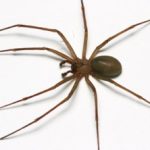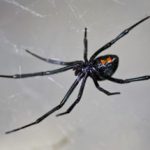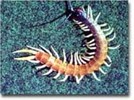 |
Brown Recluse
- So named for it's shy nature, the Brown Recluse spider tends to hide during the day and is most active at night.
- It lives in and around buildings in warm, dry places, like closets, barns, etc.
- Often called 'the fiddleback' spider because of the design of a violin on it's back between the eyes and the abdomen, the spider's venom causes death and decay of the tissue surrounding the site of the bite.
- Be aware that these spiders like to hide in dark, undisturbed places and can be fairly common in houses.
- Shake out shoes first before putting them on. Wear gloves while dusting or reaching into places where visibility is not good, especially if you notice a lot of cobwebs.
- Click to learn more about Brown Recluse Spiders
|
 |
Black Widow Spider
- It prefers protected cavities outdoors, often in portable toilets, abandoned sheds, cellars and other undisturbed places.
- It is the only shiny black spider (males and juveniles may show more color) and has a red hourglass pattern on the underside of it's abdomen.
- Only the female is dangerous to humans.
- The bite feels like a pin prick or may not be felt. There may be slight local swelling and two faint red spots surrounded by local redness at the bite. Pain may become intense within one to three hours and may continue up to 48 hours. Pain usually localizes in the abdomen and back. There may be pain in the muscles and soles of the feet, and eyelids may become swollen. Other symptoms include nausea, profuse perspiration, tremors, labored breathing and speech, and vomiting.
- During this time, a feeble pulse, cold clammy skin, unconsciousness, convulsions and even death may result if the victim does not receive medical attention immediately. Additional complications may occur due to the infection of the bite. Bites are uncommon and serious long-term complications or death are rare.
- Those at most risk of serious reaction to Black Widow venom are small children and older or infirm persons.
- Click to learn more about Black Widow Spiders
|
 |
Scorpions
- Scorpions have 4 pairs of legs, two pinchers and a segmented tail ending in a poison gland with a stinger.
- This scorpion is found throughout Texas and often under rocks or boards and other litter.
- Commonly found in homes, scorpions feed on insects, spiders, centipedes and other scorpions and is active mostly at night.
- Similar to a bee sting, the sting from a scorpion causes pain and local swelling but usually is not serious except for rare instances of allergy for which medical attention should be sought.
- Click to learn more about Scorpions
|
 |
Centipedes
- Centipedes are long, multi-segmented arthropods that have one pair of legs for each segment.
- They have poison claws located directly under the jaws.
- Centipedes prefer moist or humid areas like basements and cellars.
- The House Centipede who lives primarily indoors eats small insects such as cockroaches, clothes moths, houseflies and other insects found in homes.
- Their bite is similar to a bee sting, but because allergic reactions can occur, it is advised to consult medical care in the event of more serious symptoms.
- Click to learn more about Centipedes
|





